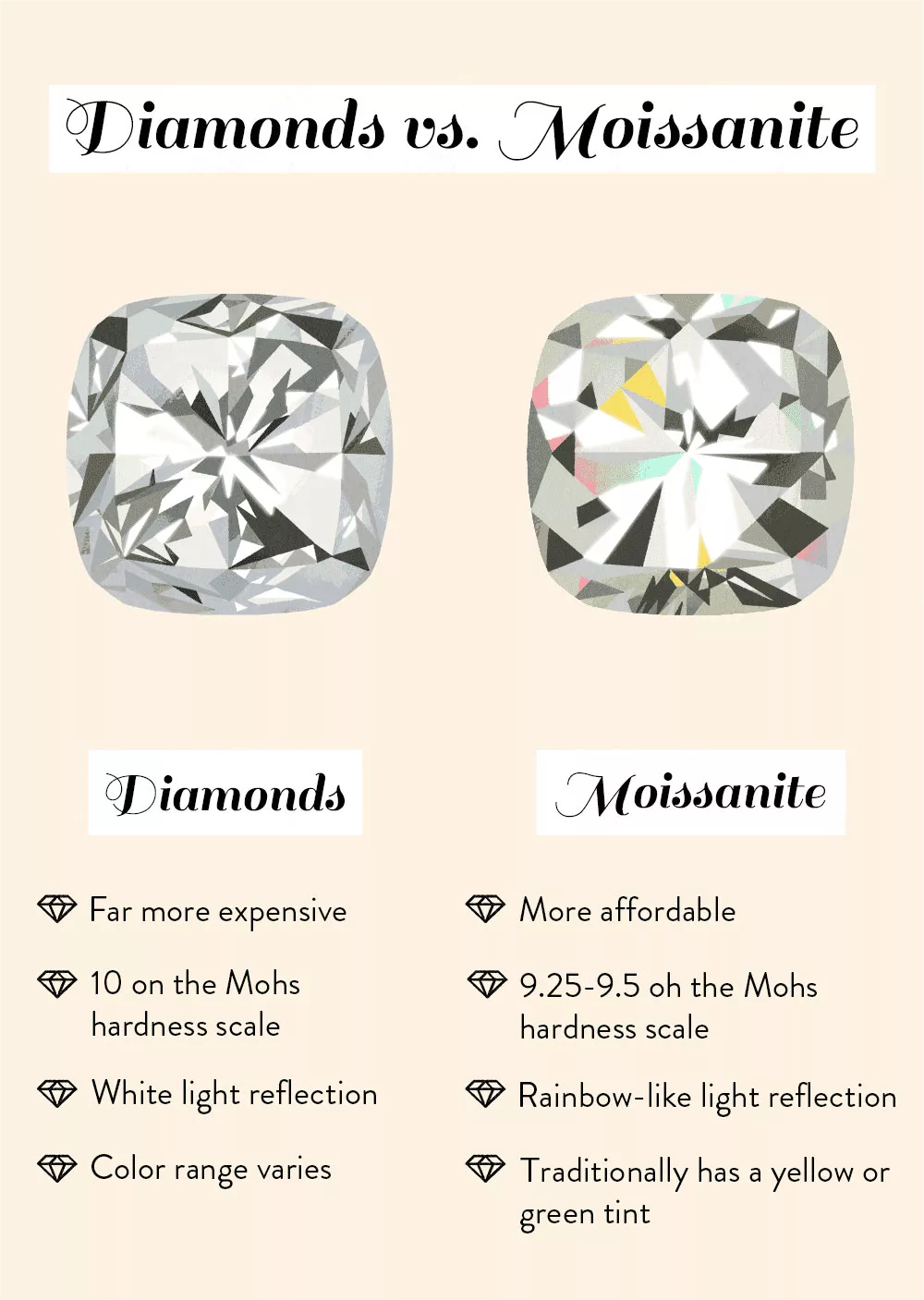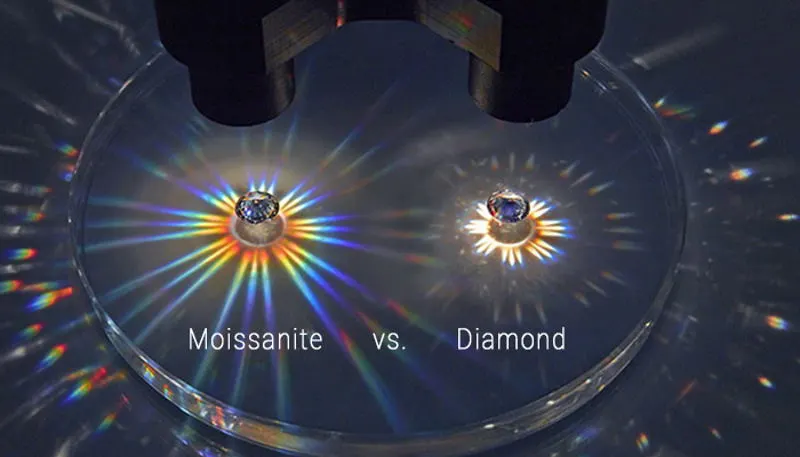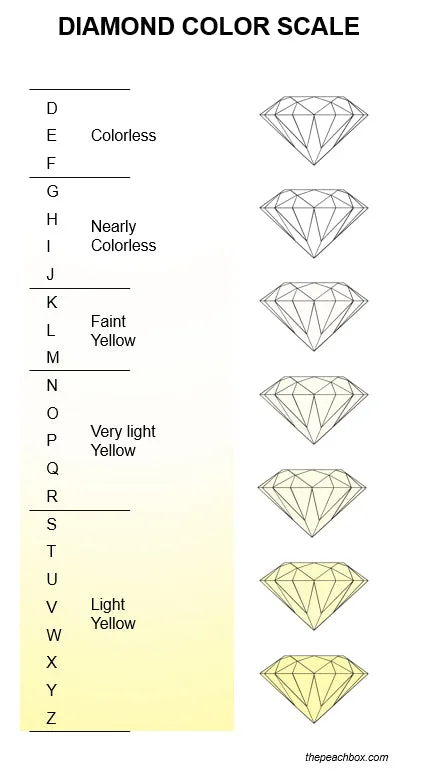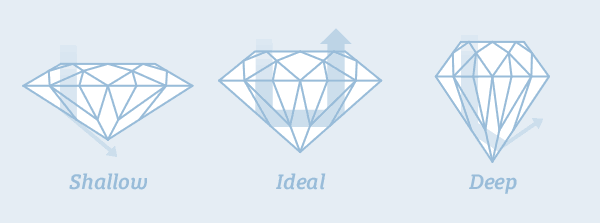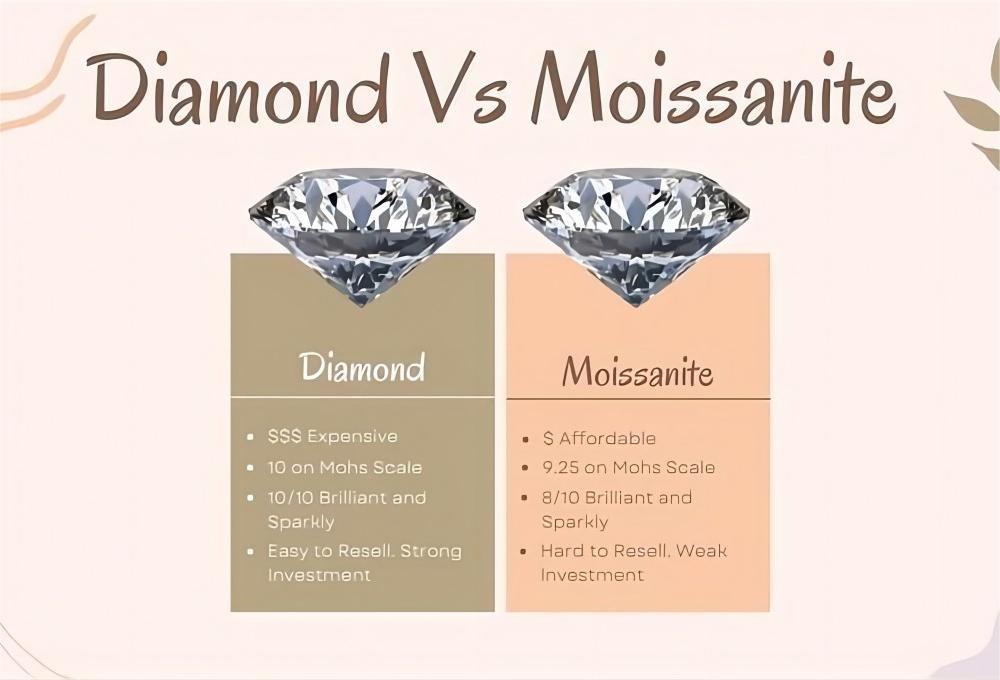
Moissanite vs. Diamonds: What’s the Difference? [2024]
The world of engagement rings may reign supreme, but diamonds are certainly not the only gemstone you can choose. You have many options for something different, including stones that look very similar to diamonds, such as moissanite.
“Moissanite is a naturally occurring mineral called silicon carbide, which is very rare and can’t be found in nature large enough to be cut into even a one-carat gemstone,” explains Don O’Connell, president and CEO of Charles & Colvard, the original creator of moissanite. This makes moissanite in fine jewelry created in a lab, unlike diamonds, which are naturally occurring.
Despite their many differences in origin, these two gemstones have plenty in common. In addition to discussing moissanite and diamonds, O’Connell and Kim Kanary discuss how they are related.
Moissanite vs. Diamonds
Moissanite vs Diamond: Price
The main advantage of moissanite over diamonds may be the fact that it is considerably cheaper than a diamond. “A moissanite gem is about one-tenth the cost of a mined diamond of equal size and quality,” O’Connell says. With greater carat weights, moissanite is more valuable.
If you want a large carat, white gemstone, but you do not have the money for a diamond, moissanite is the perfect choice. “For many, a colorless diamond with the highest clarity is impossible,” O’Connell tells me. “In my opinion, there is no reason to compromise overall quality with a lesser diamond.” Lower quality, smaller diamonds tend to cost more than larger, larger moissanite stones.
| Carat weight | Moissanite average price (USD) | Diamond average price (USD) |
| 0.5 | 1080 | 2080 |
| 0.75 | 1155 | 2180 |
| 1 | 1405 | 5180 |
| 1.5 | 1730 | 6980 |
| 2 | 1905 | 11080 |
| 2.5 | 2480 | 12180 |
| 3 | 2960 | 25980 |
Moissanite vs Diamond: Hardness
Diamonds are recognized for their durability. While they are the hardest naturally occurring mineral, they are not incredibly hard; they aren’t the toughest; thus, they can still break or chip. However, they can be worn everyday, especially for an engagement ring. Kim Kanary of JTV stated, “Diamonds do possess a high degree of hardness, so they will be significantly more resilient to abrasions.”
Despite this, moissanite does not fall far behind. “Moissanite is the second hardest to diamonds on the Mohs hardness scale,” O’Connell says. “Based on rankings from one to 10, diamonds are a 10 and moissanite is a 9.25-9.5.”
| Hardness | Substance or mineral |
|---|---|
| >10 | Nanocrystalline diamond (hyperdiamond, ultrahard fullerite) |
| 10 | Diamond |
| 9.5–10 | Boron |
| 9–9.5 | Moissanite |
| 9 | Tungsten carbide |
| 8.5 | Chromium |
| 8 | Cubic zirconia |
| 7.5–8 | Emerald |
| 7 | Quartz |
| 6–7 | Silicon |
| 6 | Titanium |
| 5.5 | Glass |
| 5 | Apatite (tooth enamel) |
| 4–4.5 | Steel |
| 4 | Iron |
| 3.5 | Platinum |
| 3 | Copper |
| 2.5–3 | Gold |
| 2–2.5 | Halite (rock salt) |
| 2 | Calcium |
| 1.5 | Lead |
| 1 | Talc |
| 0.5–0.6 | Potassium |
| 0.2–0.3 | Rubidium |
Moissanite vs Diamond: Brilliance
The brilliance of moissanite is a major difference between these two types of stones. Generally speaking, moissanite may have more brilliance than a diamond. ‘It has more fire and brilliance than any other gemstone, meaning it is more sparkling,’ O’Connell explains. Moissanite’s double refractive nature causes it to be made differently than diamonds to enhance the sparkle.”
The stone has a greater fire (or display of spectral colors) in its dispersion value than a diamond, according to Kanary. It gives way to a rainbow style effect, while diamonds reflect whiter light.
Moissanite vs Diamond: Color
Both moissanite and diamonds can be colorless or have some color. Kanary says, “Moissanite traditionally had a yellowish or greenish tint. Despite this, manufacturers have been perfecting the manufacturing process over time, so you can now get high-quality moissanite that is colorless.”
However, diamond color can vary greatly. “Diamond color is categorized as D-Z, with D being colorless, and Z being light yellow or brown (with those beyond Z being fancy color diamonds). Diamonds can be colored from yellow, pink, blue, green, red, or brown.”
Moissanite vs Diamond: Cut
As with diamonds, moissanite can be cut in many different shapes and sizes. There are round, oval, pear, cushion, princess, and radiant cut moissanites available. Some moissanites can be cut in antique cuts that were widely used for diamonds hundreds of years ago.
For moissanites, the round brilliant cut is the most popular. There are several reasons for the round brilliant cut’s popularity:
- Brilliance. The round brilliant cut offers the highest brilliance and fire ratio. The stone will sparkle when exposed to bright light, which enters into the stone and bounces off its facets in different directions.
- Color. The round brilliant cut is the best way to hide color and make a stone appear almost or completely colorless. It helps hide yellow and green tints typically found in moissanites, which is an advantage for a moissanite.
- Versatility. Round brilliant cuts are versatile, with a design that looks great in modern and vintage engagement rings.
The best cuts for moissanites are those that conceal color and emphasize its brilliance, such as the princess cut (for moissans, this shape is called the square cut), as well as the oval cut, radiant cut.
Shopping Considerations
Buying moissanite is just like buying any other gemstone, but there are a few things to keep in mind. The biggest thing to remember is that you can get quality moissanite for a reasonable price, so don’t settle for liminal stones that have visible imperfections in clarity or color. Although moissanite can contain inclusions, you should be able to find another stone that is eye-clean.”
Tips: If you shop around, you will likely find more affordable stones at the same price point. Don’t settle for low-quality stones.
What is the best way to know if a stone is high quality? Kanary says that “look for that high degree of fire, a bright shine, and a good polish with very little surface scratches.” You should shop with a retailer you trust in order to get the most for your money. In any setting, marssanite’s colour matches any other gemstone accent, including diamonds. Since it is versatile and easy to play with, finding pieces you love shouldn’t be difficult.
Advantages of Moissanite Over Diamonds
It is true that moissanites offer several advantages over diamonds, although these may not be seen as beneficial to everyone:
- Price. Moissanite is significantly less expensive than diamond, so you can purchase a larger stone at a lower price. If you are on a limited budget, this can be significant.
- Clarity. Since moissanites are produced artificially, they are generally not sold unless they have a high clarity grade. This means that it is rare to find moissanites with obvious inclusions or blemishes.
- Lab-Created. Despite this likely downside for most, some people may appreciate the technology involved in a moissanite. If you’re concerned with the ethical side of buying a diamond (a topic we’ve covered earlier), this may also be your benefit.
- Brilliance. Moissanites have a high refractive index and a distinctive color. If you’re looking for a stone with bright, eye-catching colors, you may find it unnaturally sparkly.
Disadvantages of Moissanite Over Diamonds
While moissanites have many advantages, they also have several disadvantages:
- A different kind of brilliance. Diamonds are famous for their brilliance, which is apparent yet elegantly white. On the other hand, many people might think the highly intense and very strong white sparkle of moissanite looks unnatural.
The bright and powerful brilliance of moissanite can also signal to the trained eye that it’s not a diamond.
- It’s not diamonds, at least in the cultural sense. For better or worse, diamonds are culturally significant and strongly associated with engagement, marriage and romance.
Although a moissanite might appear nice, it is unlikely to have the same meaning as a diamond. Your partner and/or peers might also view moissanite as an inexpensive, “cheap” alternative to a diamond or other traditional gemstone.
It varies from person to person. Do not let cultural factors put you off choosing the gemstone you feel most comfortable with when your fiancé is considering a moissanite engagement ring rather than a diamond-filled one.
- Lack of value. Although moissanites are cheap, they aren’t valuable. Diamonds are not a frequent investment (you will almost always lose money if you decide to sell), but they do retain some value over time and can be passed down as a family heirloom – something that you cannot do with a moissanite.
Moissanite Engagement Rings
FAQ
Is a moissanite diamond a real diamond?
Well, no, it’s a real moissanite stone. A diamond is a diamond. Moissanite is the stuff from the crater and named after a French man. I hope you enjoy reading this article, sweetie. This stone has its advantages and weaknesses. The rock is pretty and affordable. Check it out.
Do moissanite rings look fake?
Are you kidding? Of course not! They are not fake, and they don’t look fake. Moissanite stones are grown in the lab, but come from natural materials.
Some people believe diamonds have a certain charm or elegance. It’s something you find in some precious metals-they just look a little different from any imitators that may exist. If one wanted to look at the incredible clarity that these stones possess as fake, then that is possible. However, it’s also quite lovely.
How do I clean a moissanite ring?
It is recommended that you clean your moissanite ring at least once a month. Use liquid dish soap or non-toxic jewelry cleaner, put your ring in the soapy water, and gently clean it with a soft-bristled toothbrush. Let air dry or blot with a paper towel.
How is moissanite made?
Since the late 1990s, moissanite (silicon carbide) has been lab-grown. Using pressure and heat, scientists create crystals from silicon and carbon that are identical in structure to moissanite. The process is complex and takes around two to three months to create a single gem.
Where can I buy a moissanite ring?
While it may be harder to find moissanite at a physical jeweler than it is to find diamonds and other gemstones. You may be able to find a shop that sells moissanite, but it is more likely to purchase a stone from a local online retailer.
Can I pass of my moissanite as a diamond?
Sheesh, you schemer! Yeah, go ahead. Keep your eyes on yourself to make sure you don’t get caught. It would be embarrassing. The stones look pretty much like diamonds to the non-expert, except they have rainbow fire.

